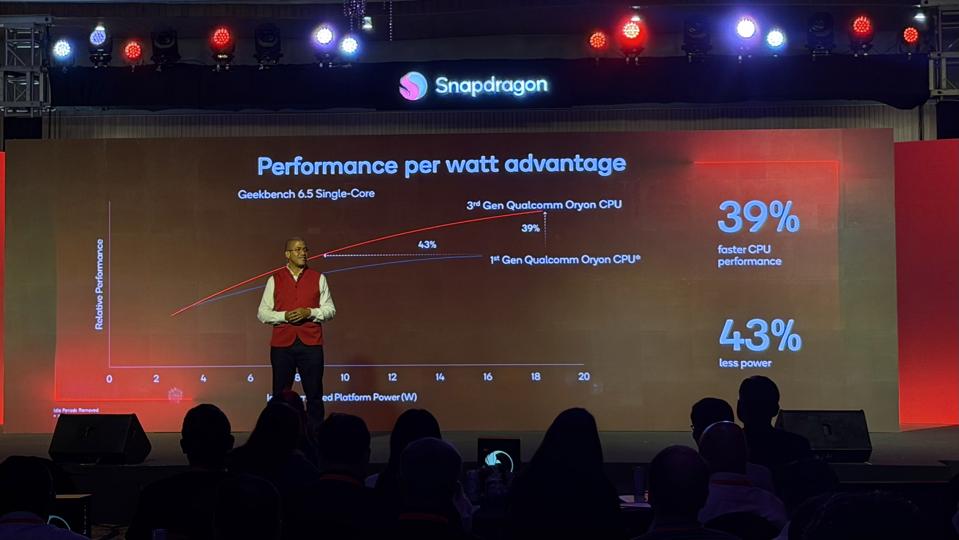Qualcomm’s upgraded chipset for 2026 Android flagship phones, the Snapdragon 8 Elite Gen 5, is finally here. The company isn’t just talking about higher clock speeds or better benchmarks but also positioning it at the prosumers, like creators who shoot and edit video on the go or gamers who want to push graphics on a handheld device.
As expected, Qualcomm claims the Snapdragon 8 Elite Gen 5 to be “the world’s fastest SoC.” It is built on TSMC’s 3nm N3P process and promises better performance per watt, less throttling under load, and improved NPU for agentic AI features that could reshape how we use our phones in 2026.
A Serious GPU And NPU Upgrade
The Snapdragon 8 Elite Gen 5 gets a new Adreno GPU promises a 23% boost in graphics performance while drawing about 20% less power. Qualcomm has also added a new Adreno High Performance Memory cache (around 18MB) to smooth out heavy rendering tasks. This should help when running complex games or pushing creative workloads.
The GPU is built for Unreal Engine 5 compatibility with Nanite geometry and Lumen support, as well as more efficient rendering through mesh shading tech.
The Snapdragon 8 Elite Gen 5 also packs the next-generation Hexagon NPU. It is said to be 37% faster than the 8 Elite’s NPU and can run the latest LLMs locally with “added AI accelerators.” It gets INT2 precision support for higher quantization of AI models. This means the new SoC will be able to run larger AI models on-device, though it could lead to accuracy trade-offs.
A Faster And More Efficient CPU
The Snapdragon 8 Elite Gen 5 houses the third generation of Qualcomm’s custom Oryon CPU cores built on Arm architecture. It runs two Prime CPU cores at 4.6GHz, up from 4.32GHz in last year’s 8 Elite, and retains the 2+6 CPU layout. The other six performance cores run at 3.62GHz. Qualcomm says you can expect up to 20% better performance compared to the Snapdragon 8 Elite.
But the real win comes in terms of efficiency. The new CPU is said to offer 35% power savings, while the entire processor is claimed to be 16% more power efficient than last year’s Snapdragon 8 Elite. In real-world usage, that means longer battery life, especially when paired with bigger silicon-carbon batteries.
Taking On The iPhones In Video Recording
The Snapdragon 8 Elite Gen 5 is the first mobile chip to support the Advanced Professional Video (APV) codec, which records at near-lossless quality. It is supposed to give creators more flexibility for color grading and editing without quality compromises.
The ISP itself has been upgraded from 18-bit to 20-bit triple processing, widening dynamic range for both photos and videos. Qualcomm also introduced a Dragon Fusion computational pipeline, aimed at pulling more detail out of low-light shots.
On the audio side, features like directional audio zoom and wind-noise reduction might make your phones double as dedicated recorders. All of these upgrades could make 2026 Android flagship phones worthy rivals to the new iPhone 17 Pro for creators and prosumers.
Connectivity And Other Upgrades
The new flagship Qualcomm SoC features a Snapdragon X85 modem, which is said to hit 12.5Gbps downlink and 3.7Gbps uplink peak speeds. It is claimed to be more power-efficient while also improving location accuracy.
Phones powered by the Snapdragon 8 Elite Gen 5 chipset should hold their performance longer, whether you’re recording video for extended periods or playing games for long sessions.
With the Snapdragon 8 Elite Gen 5, Qualcomm isn’t only chasing benchmark bragging rights. It seems to have built a chip that blends raw power with efficiency while giving creators, gamers, and everyday users features they’ll actually notice. It could make 2026 Android flagships feel like true productivity and creativity-focused phones.

